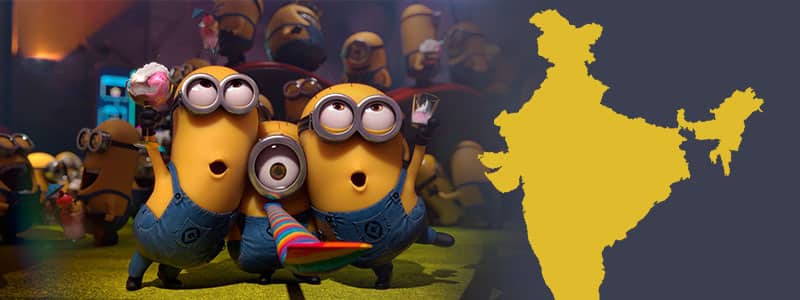The Incredible Hulk, The Narnia franchise, HOP, X-Men First Class, Knight and Day, The Mummy franchise, Night at the Museum 1&2, Alvin & The Chipmunks series, The Golden Compass…… No this is not my “to watch” list during the holidays. These are films that have a very unique connection, something the average movie goer would not be able to guess unless I told them. You see, all these films had their animation produced in India, or should I say that their multimedia animation needs were outsourced to Indian firms. Why, you may ask. Or the fact that I mentioned outsourcing to you might encourage you to say “Was it the cost?”. Well, you wouldn’t be wrong either. Cost was and still is the driving force behind all outsourcing stories. However, there is one more crucial reason why India was chosen as the destination, especially given the fact that countries like Korea, Taiwan and Philippines also have a thriving animation industry. Its quality!
A nation in thrall of the silver screen
Hollywood produces around 600 films a year, give or take a few. The Academy of Motion Pictures probably reviews around 700-800 films, released in LA county in the past year from all over the world before announcing the Oscars shortlist (nominations if you will). In India, that number would mean a slow year in terms of film production. India produces more than 1000 movies in a calendar year in more than 10 languages. While the world knows mostly about Bollywood (the Bombay wordplay on Hollywood), there are as many as four major film industries in India, with three of them functioning completely independent of Bollywood, all with their own dedicated audience base and independent technical expertise. Added to that there are as many as five other regional film industries which are smaller but largely independent. This unique situation exists because India is a nation of as many as 21 official languages, with each one commanding a linguistic base that runs into many millions. In fact, the most well-known film makers from India, people like Satyajit Ray (many called him India’s Kurosawa) never worked in Bollywood! So imagine the scale at which the entertainment industry functions in India. However, if there is one thing that all Indians have in common, it is their love of the silver screen! If one goes to the IT hubs of Hyderabad, Bangalore, Chennai etc, the thing that will hit you is the number of cinema theatres. And huge ones too! There is one practically in every corner. The average Indian’s idea of relaxing is going and watching a film. Films become family affairs, with the entire family making an evening out of it. And while good cinema sure has enough patronage in India, what the average Indian cinema goer really likes are films which are massive in every way. Larger than life characters, heroes whose every movement is accentuated by CGI, dance sequences which are otherworldly and titanic in proportion. Cinema as mass entertainment rules more than cinema the delicate art form, since Indian audiences find glitzy commercial content easier to digest and stress bursting. So what does all this lead to? It means that almost every film made in India needs to include top of the line multimedia animation in some way or the other. Be it for cars flying, or creating the Garden of Eden for a song sequence.
For this reason, animation as a career option has literally exploded in the last two decades. A survey done in 2014 counted more than 300 animation studios and more than 15000 top of the line animation artists. That Hollywood would not need to look no further East than India when it wanted to outsource animation services was a given. It still is. Over the past few years the industry has made significant strides in South Korea, Taiwan and Philippines too, with the quality of work rather good in South Korea and Taiwan. But the numbers are still extremely pale in front of India as a destination. Today, mostly boutique Indian animation firms lead the way globally in Rotoscopy, Motion Tracking, Stereoscopic VFX, Matte Painting and 2D to 3D conversions to name a few.
While Indian firms keep improving on the mantra of “Job right the first time” let’s have a look at
The India price advantage in numbers:
- A 30 minute 3D program would cost between $250000 to $ 400000 in US or Canada. In India, the corresponding number is $ 60000.
- Despite being outsourcing destinations themselves and having nowhere near the kind of domestic demand that India has, Taiwan and South Korea are 30% to 40% more expensive than India. In fact in terms, India even triumphs Philippines!
So the basically where we stand at is this. India is
- Cheaper
- Technically superior talent, thanks to local consumption
- More experienced animators thanks to the demand within India.
Hence
Hence, not looking at India while looking to outsource one’s animation needs will actually look quite foolish. Work done by Indian animation studios have garnered numerous awards, including Emmys and the Academy Award (Golden Compass for Visual Effects). The industry by itself is growing at a healthy clip of almost 10% every year, on an average. More and more Indians are realizing that animation is probably a better and more fun option than “software engineering”, which off course still retains the almost holy stature attached to it, but is less appealing to many, given the kind of grind involved (Competition is crazy in India!). Moreover, as a society, India has always been known for its creativity and arts. Multimedia animation is hence a natural fit in this environment; and what has been heartening to see is the number of women joining the animation bandwagon annually. Signs are good, and India will continue to churn out top of the line and cheap animation for Western Clients for the foreseeable future, becoming the global hub in this field.
